 W
WThis is a list of dishes in the Cuisine of Morocco. Entries in beige color indicate types of generic foods.
 W
WMoroccan cuisine is influenced by Morocco's interactions and exchanges with other cultures and nations over the centuries. Moroccan cuisine is usually a mix of Amazigh, Andalusian, and Mediterranean cuisines, with slight European and sub-Saharan influences.
 W
WIn Moroccan cuisine, Ahriche is a dish eaten by the tribes of Zayanes and Khénifra. The name is derived from the Berber word for stick; this is in reference to the dish's manner of cooking. It is a dish of tripe usually consisting of ganglion, caul, lung or heart of an animal wound with intestines on a stick of oak and cooked on hot coals.
 W
WAmlu, also spelled as amlou and known also as Amalu is a spread of Moroccan cuisine. It consists of argan oil, almonds and honey. The almonds are toasted, which are then crushed and kneaded with honey and argan oil. Amlou is usually served for breakfast or afternoon tea with pancakes and pastries.
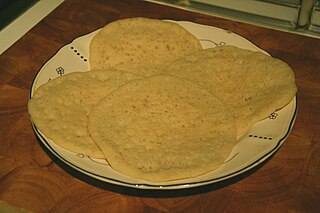 W
WBaghrir or beghrir (البغرير) is a pancake consumed in the Maghreb region. They are small, spongy and made with semolina or flour; when cooked correctly, they are riddled with tiny holes. The most common way to eat baghrir in Algeria and Morocco is by dipping them in a honey-butter mixture, but they can also be cut into wedges and served with jam. It is common to add raisins to the pancake as well. Baghrir are popular for breakfast, as a snack and for iftar during Ramadan.
 W
WBeer production in Morocco was introduced by the French in the 20th century. Société des Brasseries du Maroc is part of the Castel Group and oversees the production and distribution of beer. Popular beers include Spéciale Flag (pilsner) and Stork. The Moroccan premium beer is Casablanca, which costs more than the other two. Casablanca is also exported and, for instance, served in the Morocco pavilion at Epcot in Walt Disney World, Orlando, FL.
 W
WBissara, also known as Bessara, Besarah and Tamarakt is a soup and a bean dip in North African cuisine. Its origin was in ancient Egypt, prepared with dried, puréed broad beans as a primary ingredient. Additional ingredients include garlic, olive oil, lemon juice, hot red pepper, cumin, and salt. Bissara is sometimes prepared using split peas or chickpeas. In Egypt, bissara also includes herbs or leafy greens—particularly parsley, mint, dill, spinach, or molokhiya, though the latter is more commonly added by Egyptian expatriates in Palestine—and is eaten with bread as a dip. It is typically inexpensive, and has been described as a pauper's dish.
 W
WBorek or burek is a filled pastry made of a thin flaky dough such as filo with a variety of fillings, such as meat, cheese, spinach or potatoes. Boreks are mainly associated with the areas of the former Ottoman Empire, including the Balkans and the Caucasus, the Middle East, Eastern European and Central European countries, Northern Africa and Central Asia. A borek may be prepared in a large pan and cut into portions after baking, or as individual pastries. They are usually baked but some varieties can be fried. Borek is sometimes sprinkled with sesame or nigella seeds, and they may be served hot or cold.
 W
WA briouat or briwat is a sweet or savory puff pastry. It is part of the Moroccan cuisine. Briouats are filled with meat mixed with cheese, lemon and pepper. They are wrapped in warqa in a triangular or cylinder shape. Briouats can also be sweet, filled with almond or peanut paste and fried, then dipped in warm honey flavored with orange blossom water.
 W
WBsisa is a typical Mediterranean food, based on flour of roasted barley which dates back to Roman times.
 W
WThe Chebakia is a pastry of Moroccan origin made of strips of dough rolled to resemble a rose, deep-fried until golden, then coated with a syrup made of honey and rosewater and sprinkled with sesame.
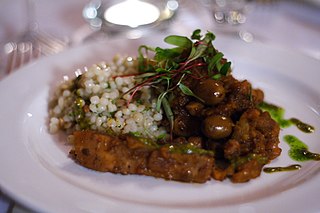 W
WChermoula or charmoula is a marinade and relish used in Algerian, Libyan, Moroccan and Tunisian cooking. It is traditionally used to flavor fish or seafood, but it can be used on other meats or vegetables.
 W
WChraime is a spicy fish stew with tomatoes from Libya. The name of the dish comes from the Arabic word for "hot".
 W
WCouscous is a North African dish of small steamed granules of rolled durum wheat semolina that is traditionally served with a stew spooned on top. Pearl millet, sorghum, Bulgur and other cereals can be cooked in a similar way in other regions and the resulting dishes are also sometimes called couscous.
 W
WA couscoussier is a traditional double-chambered food steamer used in Berber cuisine to cook couscous.
 W
WQurabiya is a shortbread-type biscuit, usually made with ground almonds. Versions are found in most countries of the former Ottoman Empire, with various different forms and recipes.
 W
WHarcha is a semolina bread native to the Middle Atlas in Morocco, and also found in Algeria.
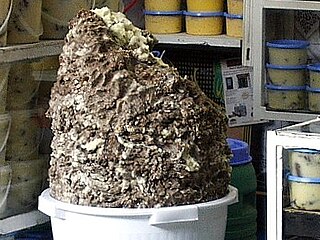 W
WKhlea or khlii is a preserved meat, usually made with beef or lamb, originating from Morocco. Khlea is made by cutting meat into strips and letting it dry in the sun after marinating it in garlic, coriander and cumin. The meat is cooked in a mixture of water, oil and animal fat. Upon cooling, the meat is submerged in more animal fat and left to dry. Khlea can be preserved for up to two years at room temperature.
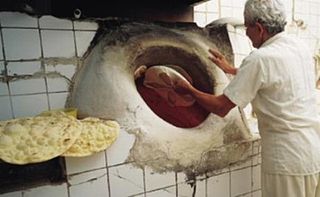 W
WKhubz, alternatively transliterated as khoubz, khobez, khubez, or khubooz, from, is the usual word for "bread" in Standard Arabic and in many of the vernaculars.
 W
WM'semen or msemen, is a traditional flatbread originally from the Maghreb, common to Algeria, Tunisia and Morocco. It is usually served with honey or a cup of aromatic morning mint tea or coffee. M'semen can also be stuffed with meat (khlea) or onion and tomatoes.
 W
WMahia is a Moroccan Jewish alcoholic beverage distilled from dates. It is also sometimes prepared with figs.
 W
WMakroudh is a cookie from the cuisines of the Maghreb and Malta. It is filled with dates and nuts or almond paste, that has a diamond shape – the name derives from this characteristic shape.
 W
WMatbukha is a Maghrebi dish of cooked tomatoes and roasted bell peppers seasoned with garlic and chili pepper. The name of the dish originates from Arabic and means "cooked" in Arabic. It is served as an appetizer, often as part of a meze table. Matbukha is popular across the Maghreb and in Israel, to where it was brought by Jewish immigrants from Morocco, Tunisia, Algeria, and Libya.
 W
WMerienda is a light meal in southern Europe, particularly Spain, Portugal (merenda), Catalan speaking places (berenar), Aragonese speaking places and Italy (merenda), as well as Hispanic America, the Philippines, North Africa (Morocco) and Brazil. Usually taken in the afternoon or for brunch, it fills in the meal gap between the noontime meal and the evening meal, being the equivalent of afternoon tea in the English-speaking world; or between breakfast and lunch. It is a simple meal that often consists of a piece of fruit, cookies, yogurt, and other snacks paired with juice, milk, hot chocolate, coffee, spirits, or other beverages.
 W
WThe Moroccan citron is a true citron variety native to Assads, Morocco, which is still today its main center of cultivation.
 W
WMrouzia is one of the most important dishes of Moroccan cuisine. It is a sweet and salty meat tajine, combining a ras el hanout blend of spices with honey, cinnamon and almonds. It is also prepared in Tunisia, but in a different manner. An author mentions the name in Algeria, but for a different dish.
 W
WPaprika is a spice made from dried and ground red peppers. It is traditionally made from Capsicum annuum varietals in the Longum group, which also includes chili peppers, but the peppers used for paprika tend to be milder and have thinner flesh. In some languages, but not English, the word paprika also refers to the plant and the fruit from which the spice is made, as well as to peppers in the Grossum group.
 W
WPastilla is a North African meat or seafood pie made with warqa dough (ورقة), which is similar to filo. It is a specialty of Morocco and Algeria. It has more recently been spread by emigrants to France, Israel, and North America.
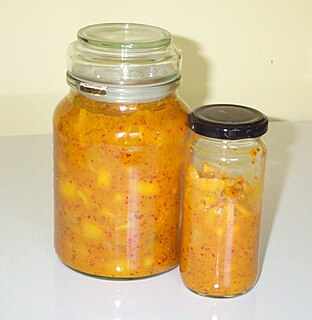 W
WPreserved lemon or lemon pickle is a condiment that is common in the cuisines of Indian subcontinent and North Africa. It's also found in 18th-century English cuisine.
 W
WRas el hanout or rass el hanout is a spice mix found in varying forms in Tunisia, Algeria, and Morocco. The name in Arabic means "head of the shop" and implies a mixture of the best spices the seller has to offer. Ras el hanout is used in many savory dishes, sometimes rubbed on meat or fish, or stirred into couscous, pasta or rice.
 W
WRfissa is a dish that is very popular in Morocco and is served during various traditional celebrations.
 W
WRhobs al-Arsa is a very popular citrus fruit in Morocco.
 W
WRick’s Café Casablanca is a restaurant, bar and café located in the city of Casablanca, Morocco. Opened March 1, 2004, the place was designed to recreate the bar made famous by Humphrey Bogart and Ingrid Bergman in the movie classic Casablanca. Set in an old courtyard-style mansion built against the walls of the Old Medina of Casablanca, the restaurant – piano bar is filled with architectural and decorative details reminiscent of the film: curved arches, a sculpted bar, balconies, balustrades as well as beaded and stencilled brass lighting and plants that cast luminous shadows on white walls. There is an authentic 1930s Pleyel piano and As Time Goes By is a common request to the in-house pianist.
 W
WCholent or hamin is a traditional Jewish stew. It is usually simmered overnight for 12 hours or more, and eaten for lunch on Shabbat. Cholent was developed over the centuries to conform with Jewish laws that prohibit cooking on the Sabbath. The pot is brought to a boil on Friday before the Sabbath begins, and kept on a blech or hotplate, or left in a slow oven or electric slow cooker, until the following day. Cholent originated in ancient Judea, possibly as far back as the Second Temple period, and over the centuries various Jewish diaspora communities created their own variations of the dish.
 W
WSeffa is a Maghrebi dish of sweetened semolina cuscus with butter, cinnamon, and almonds. It can also be made with rice or vermicelli. This dish is generally consumed at the end of a meal, before dessert. It is often served at traditional marriage ceremonies and family gatherings.
 W
WSellou, also called slilou or sfouf, is a dessert consumed in Morocco. It is made from a base of roasted flour mixed with butter, honey, almonds, sesame, and possibly other nuts and spices, it is one of the important dishes in Morocco during the holy month of Ramadan.
 W
WSemolina is the coarse, purified wheat middlings of durum wheat mainly used in making couscous, pasta, and sweet puddings. The term semolina is also used to designate coarse middlings from other varieties of wheat, and sometimes other grains as well.
 W
WSfenj is a Maghrebi doughnut: a light, spongy ring of dough fried in oil. Sfenj is eaten plain, sprinkled with sugar, or soaked in honey. It is a well-known dish in the Maghreb and is traditionally made and sold early in the morning for breakfast or in the late afternoon accompanied by tea—usually Maghrebi mint tea—or coffee. It is also called Khfaf in Algeria and other parts of the Maghreb, bambalouni in Tunisia, and sfinz in Libya.
 W
WShakshouka is a Maghrebi dish of eggs poached in a sauce of tomatoes, olive oil, peppers, onion and garlic, commonly spiced with cumin, paprika and cayenne pepper. According to Joan Nathan, shakshouka originated in Ottoman North Africa in the mid-16th century after tomatoes were introduced to the region by Hernan Cortés as part of the Columbian exchange.
 W
WSmen is a salted, fermented butter, and a traditional Yemeni dish. In Yemen, Yemenis prepare a special version of semneh (سمنة) which is smoked with aromatic herbs inside of a gourd in order to impart deeper flavour and aid in preservation. However, smen is also an important ingredient in Middle Eastern cuisine and North African cooking. It is produced using the butter made from the milk of sheep, goats or a combination of the two. The butter is brought to its boiling point for about 15 minutes, then skimmed, strained into a ceramic jar called a khabia, and salted before it curdles. Some have it as a practice to add roasted fenugreek seeds to the boiling butter, after which it is strained from the fenugreek seeds. Thyme is often added to it to provide a yeast and enzyme starter. Other plants or fruits can be used. The result is then aged, often in sealed containers. It is then traditionally buried in the ground for temperature stability purposes, just like cheese is left to mature in caves because they have cooler and more stable temperatures.
 W
WA tajine or tagine is a Berber dish, named after the earthenware pot in which it is cooked. It is also called maraq or marqa.
 W
WTangia is an urn-shaped terra cotta cooking vessel. It is also the name of the stew cooked in the pot. It is common in Marrakech, Morocco.
 W
WTharid is a traditional Arab dish made from pieces of bread in a vegetable or meat broth. It is typically consumed in especially the holy month of Ramadan and is quite popular in Arabia.
 W
WAmong the countries of North Africa, Morocco is considered to have the best natural potential for producing quality wines, due to its high mountains and cooling influence of the Atlantic, as these factors offset the risk of having too hot vineyards. An important exporter of wine in the colonial era before 1956, the Moroccan wine industry is experiencing a revival and expansion since the 1990s due to influx of foreign investments.
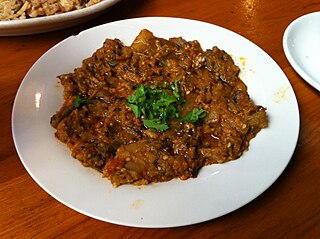 W
WZaalouk or Zalouk is a Moroccan salad of cooked eggplants and tomatoes. The eggplant is first grilled and then mixed with the tomatoes and the mix is seasoned with garlic and spices.